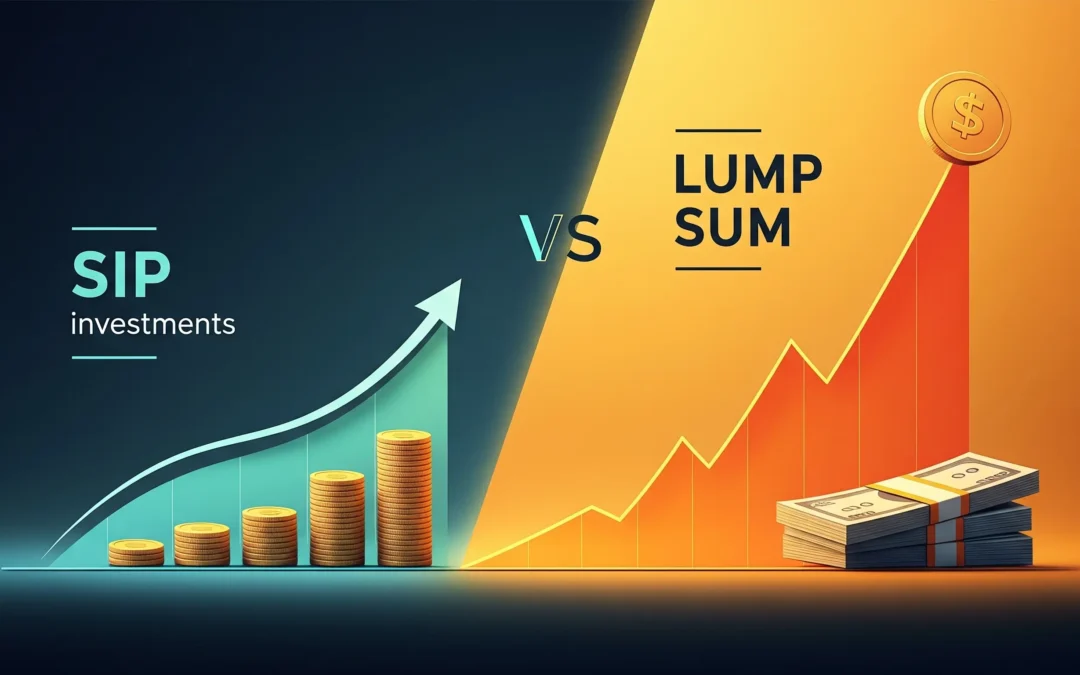In a world where everything is changing, including the finance sector, the SIP vs. Lump Sum investment decision remains a burning debate among investors. As 2025 brings in new economic challenges from moderation of global inflation to uncertain stock market volatilities, it becomes increasingly vital to know about these two methods under varying conditions.
Which strategy is superior in 2025? It depends on several factors such as your income stability, market scenario, financial objectives, and risk appetite. In this article, we explore both strategies in detail to guide you in making a well-informed decision.
What is a SIP (Systematic Investment Plan)?
A Systematic Investment Plan or SIP is an investment strategy where a constant amount is invested at periodic intervals -commonly monthly – into a mutual fund scheme. SIPs are preferred by retail investors as they enable disciplined investments without having to time the market.
Advantages of SIP:
- Rupee Cost Averaging: When the market goes down, your fixed sum purchases more units; when the market goes up, it purchases fewer. This evens out the average unit cost over time.
- Disciplined Approach: It helps you make your investing habit automatic, so that you save a certain sum of money.
- Budget-Friendly: Begin with as low as ₹500/month and is ideal for students, early starters, or conservative investors.
- Lower Emotional Bias: Scheduled investing eliminates the urge to time the market based on fear or greed. It happens automatically as per the date set.
What is Lump Sum Investing?
Lump Sum investing involves making a single investment of the entire amount into a fund. It is most often favoured by those who get windfalls, such as bonuses, inheritance, or insurance maturity proceeds.
Advantages of Lump Sum:
- Early Compounding Power: The whole invested amount starts growing from day one, making the most of compounding power.
- Simplicity: It’s a one-time initiative with no monthly reminders or transaction arrangements.
- Best for Bullish Markets: If the market is in a rising trend, Lump Sum can yield more returns than SIP.
2025 Outlook: Which Strategy Wins?
The SIP vs. Lump Sum performance in 2025 relies on three crucial realities of the market:
1. Market Volatility Still Lingers
With geopolitical tensions, global control over inflation, and volatile interest rates, market volatility is likely to persist. It favours the SIP strategy, which saves one from market lows and highs by averaging costs in rupees.
Example:
During 2022–2024, mutual funds, including large-cap funds like Axis Bluechip, saw fluctuations due to market cycles. SIP investors during this period benefited from lower average purchase prices compared to lump sum investors who entered the market at peaks.
2. Interest Rates Levelling Out, but Inflation Remains an Issue
In 2025, the RBI continues to have moderate interest rates. That makes mutual funds, particularly equity-based, a better bet for long-term goals. If you have a lump sum sitting around, early investment can make it grow more with compounding, provided the market doesn’t implode.
3. Investor Profile is Crucial
Since investment is a subjective topic, investor profile holds a great weightage in deciding the best choice between SIP and lump-sum.
- Salaried Millennials or beginner investors – SIP is best for affordability and regularity.
- High-earning professionals or bonus earners – Can opt for a Lump Sum if they study market scenarios in advance.
Opt for SIP if:
- You are a new investor.
- You like disciplined, long-term wealth accumulation.
- You do not have a big corpus to invest at the beginning.
Opt for Lump Sum if:
- You have received a sudden windfall (bonus, inheritance).
- The market is at a relatively good valuation, and you have a long investment horizon.
- You can endure short-term fluctuations.
Bottomline
Both SIP and Lump Sum investing are effective, but they require alignment with your financial situation, goals and market conditions. SIPs provide the advantage of even-outing market risks, particularly for investors drawing from regular income. Lump-sum investments can generate higher returns if invested during market corrections or in the early phase of a bull run, but this also involves a greater risk of market timing.
Ultimately, consistency, awareness, and discipline are more important than trying to predict markets. Whichever path you choose, ensure it aligns with your financial goals, and don’t hesitate to consult a certified advisor to optimize your wealth-building journey in 2025.
Written by: Tanya Kumari


